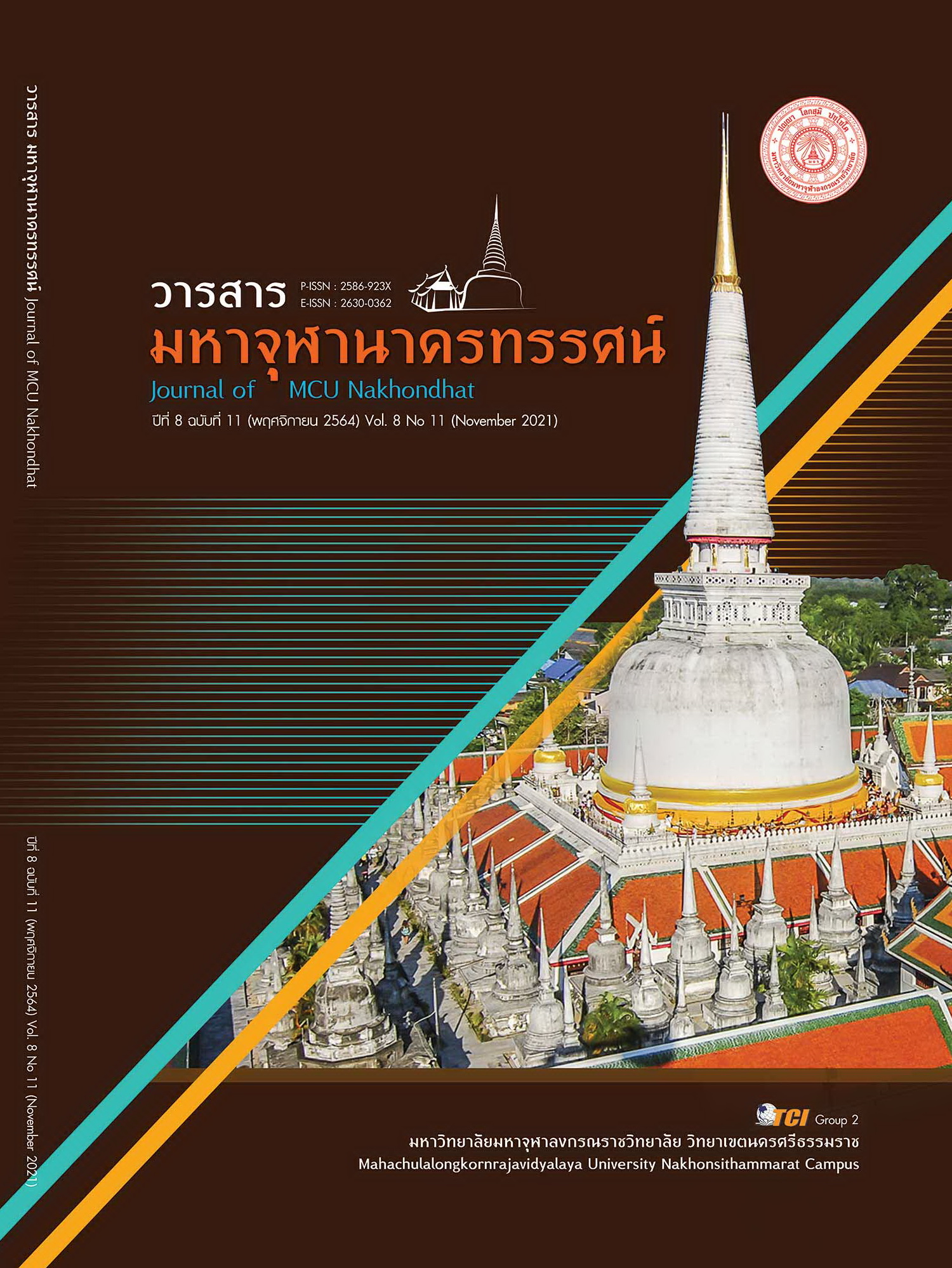THE ROLE OF NURSES IN CARING FOR FIRST-TIME MOTHERS WITH POSTPARTUM DEPRESSION
Main Article Content
Abstract
Postpartum depression is a mood change. Emotions that occur between 6 weeks postpartum until 1 year postpartum are when postpartum mothers adjust to the role of motherhood. parenting including increased obligations If the mother after childbirth cannot face the changes that have occurred. would result in postpartum depression problems especially in first-term mothers who do not have experience in childbirth and maternity. which in today's society is more of a single-family Husband has to work outside the home. The burden of raising children must belong to the wife alone. As a result, the mother's mood and behavior changed from the original. coupled with social and economic changes in the present the burden of increasing expenses including psychosocial factors such as motherhood attitude self-esteem Childcare stress Mother's depression after giving birth relationship between spouses and social support. These are all factors that contribute to postpartum depression. The midwife therefore plays an important role in caring for the first-born mother. at all stages of pregnancy especially in the postpartum period both in terms of assessment for initial screening including prevention and surveillance of postpartum depression and the role of nurses in caring for when depression occurs. Therefore, this academic paper aims to present the content of postpartum depression. including the role of midwives in caring for first-time mothers with postpartum depression. This will be a guideline for planning an appropriate, holistic and holistic nursing care plan for the first mother.
Article Details
References
นภัสนันท์ สุขเกษม. (2559). ปัจจัยทำนายภาวะซึมเศร้าหลังคลอด. วารสารการพยาบาลและการดูแลสุขภาพ, 34(1), 61-69.
นลินี สิทธิบุญมา และคณะ. (2563). ความเครียด การสนับสนุนทางสังคมและภาวะซึมเศร้าหลังคลอดของผู้ที่เป็นมารดาครั้งแรก. พยาบาลสาร, 47(2). 169-179.
พรทิพย์ วงศ์วิเศษศิริกุล และคณะ. (2543). ความสัมพันธ์ระหว่างปัจจัยส่วนบุคคล แรงสนับสนุนจากคู่สมรส การเปลี่ยนบทบาทการเป็นมารดา และอาการซึมเศร้า ภายหลังคลอด. รามาธิบดีพยาบาลสาร, 6(3), 201-212.
มยุรัตน์ รักเกียรติ์ และประนอม พูลพัฒน์. (2563). ความชุกและปัจจัยที่เกี่ยวข้องกับภาวะซึมเศร้าหลังคลอดในมารดาวัยรุ่น โรงพยาบาลนพรัตนราชธานี. วารสารคณะพยาบาลศาสตร์ มหาวิทยาลัยบูรพา, 28(1), 38-47.
วรรณี นวลฉวี. (2561). ความชุกของภาวะซึมเศร้าหลังคลอดและปัจจัยทำนายภาวะซึมเศร้าหลังคลอด ในมารดาหลังคลอด. วารสารมฉก.วิชาการ, 21(42), 65-71.
วัลยา เชาว์พานิชย์เวช. (2555). ความชุกและปัจจัยที่เกี่ยวข้องกับภาวะซึมเศร้าหลังคลอด ในโรงพยาบาลกลาง. วารสารโรงพยาบาลเจริญกรุงประชารักษ์, 8(1), 13-21.
วาสนา มั่งคั่ง และคณะ. (2562). ภาวะบลู-สภาวการณ์ซึมเศร้าของ หญิงหลังคลอด. วารสารวิชาการสาธารณสุข, 28(ฉบับพิเศษ). 13-19.
อักษราณัฐ ภักดีสมัย. (2560). ปัจจัยทำนายภาวะซึมเศร้าหลังคลอดในผู้ที่เป็นมารดาครั้งแรก. พยาบาลสาร, 44(3), 19-29.
Abdollahi, F. et al. (2016). Postpartum mental health in first-time mothers: a Cohort study, Iran. Journal of Psychiatryand Behavioral Sciences, 10(1) :426-426.
Beck C. T., & Driscoll J.W. (2006). Postpartum mood and anxiety disorder: a clinicians guide. Burlington: Jones and Bartlett Publishers Inc.
Beck, C. T. (1998). A checklist to identify women at risk for developing postpartumdepression. Journal of Obstetric Gynecologic and Neonatal Nursing, 27(1), 39-46.
Beck, C. T. (2001). Predictors of postpartum depression. Nursing Research, 50(5),275-285.
Beck, C. T. (2002). Revision of the postpartum depression predictors inventory. Journal of Obstetrics Gynecology & Neonatal Nursing, 31(4), 394-402.
Beck, C. T., & Gable, R. K. (2000). Postpartum depression screening scale: Development and psychometric testing. Nursing Research, 49(5),272–282.
Caron, Z. et al. (2016). Randomized controlled trial to prevent postpartum depression in mothers on public. Journal affects disorder, 1(189) ,263-268.
Cox, J. L. et al. (1987). Detection of postnatal depression:Development of the 10 item Edinburgh Posnatal Depression Scale. British Journal of Psychiatric, 150(6), 782-786.
Demirchyan, A. et al. (2014). Rate and predictors of postpartum depression in a 22-year follow-up of a cohort of earthquake survivors in Armenia. Archives of Women’ Mental Health Journal, 17(3), 229-237.
Foster, D. A. et al. (2008). The early postnatal period: Exploring women’s viewsexpectations and experiences of care using focus groups in Victoria, Australia. Biomed central pregnancy and childbirth, 27(8). 1-11.
Gao, L. et al. (2009). Depression, perceived stress, and social support among first-time Chinese mothers and fathers in the postpartum period. Research in Nursing & Health, 32(1), 50–58.
Ihongbe, T. O. & Masho, S. W. (2017). Do successive preterm birth increase the risk of postpartum depressive symptoms. Journal of Pregnancy, 2017(1), 1-10.
Leahy-Warren, P. et al. (2011). First-time mothers: Social support, maternal parental self-efficacy and postnatal depression. Journal of Clinical Nursing, 21(3-4), 388–397.
Li, L. et al. (2011). Chinese version of the postpartum depression screening scale translation and validation. Nursing Research, 60(4), 231-239.
Lucci, T. K., & Otta, E. (2013). Postpartum depression and child development in first year of life. Estudos de Psicologia (Campinas), 30(1), 7-17.
Michael, W. et al. (2013). Postpartum depression: current status and future directions. Annual Review Clinical Psychology, 2013(9), 379-407.
Mohammed, E. S. et al. (2014). Predictors of postpartum depression among rural women in Minia Egypt: An epidemiological study. Public Health, 128(9), 817-824.
Panyayong, B. (2013). Postpartum depression among Thai women: A national survey. Journal of the Medical Association of Thailand, 96(7), 761-767.
Pearlstein, T. et al. (2008). Postpartum depression. American Journal of Obstetrics & Gynecology, 200(4). 357-364.
Radloff, L. (1977). A self-report depression scale for research in the general population. Applied Psychological Measurement, 1(3), 385–401.
Rubin, R. (1984). Maternal identity and the maternal experience. New York: Springer.
Sockol, L. E. et al. (2014). The relationship between maternal attitudes and symptoms of depression and anxiety among pregnant and postpartum first-time mothers. Archives of Women's Mental Health: 17(3),199-212.
Vittayanont, A. et al. (2006). Development of Postpartum Depression Screening Scale (PDSS): A Thai version for screening postpartum depression. Journal of The Medical Association of Thailand: 89(1), 1-7.
World Health Organization. (2015). Maternal mental health. Retrieved september 15, 2016, from https://www.who.int/teams/mental-health-and-substance-use/maternal-mental-health


